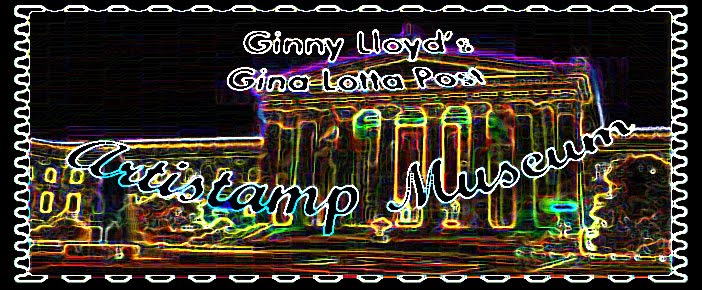|
Given the planetary diffusion of philately and the spontaneous human
propensity for the imitation and parody of formats of daily use, we may
come across countless examples of unofficial postage stamps, produced for
the most diverse purposes by commercial firms, illustrators, comics
artists, or even by people with no artistical background. Fake stamps are
often made just for the fun of it, to play a joke or to decorate an
envelope, without remotely suspecting the existence of a complex and
consolidated tradition with an higher cultural profile for this sort of
“alternative philately”. Though it has been around for over forty years,
correspondence art or mail art - as it is internationally best known -
remains in fact very much an underground phenomenon, snubbed by most art
history books. This is principally due to the unpretentious size and
ephemeral nature of mail art works, usually small creations that do not
move large finantial interests: postcards and letters (but also zines,
books, cassettes, videos, etc.) freely exchanged among artists and not
primarily intended for sale.
The practice of creative postal communication emerged in the early
1960’s from the seminal activities of the international Fluxus group lead
by George Maciunas and from the playful mailings of Ray Johnson’s New York
Correspondance School. Illustrious precedents may be found also among the
ranks of the Dadaists, Futurists and Surrealists. In the 1970’s and 1980’s
mail art assumed a more definite configuration as an eternal network (a
term coined by Fluxus theorist Robert Filliou) constituted by thousands of
contacts spread in every corner of the planet, a web in continuous
transformation that reacted to the impersonal and alienating one-way
communication of the mass media and to the often perverse mechanisms of
the art market. Mail-artists preferred instead the intimate two-way
contact that could be obtained through a simple and unexpensive medium
like postal correspondence (in large part replaced today by e-mail),
aiming at the total dismantlement of the barriers between art and life. If
the personal and unselfish contact can be considered the true beating
heart of mail art, shows and publications devoted to this form of
expression became also widespread, usually requesting works on a given
theme and in a specific format, like postcards, envelopes and artist’s
stamps (or “artistamps”).
From the very beginning, with the pioneering work of Fluxus artists
such as Maciunas, Robert Watts and Ben Vautier, the participants in this
pragmatic and open network took pleasure in the transformation and satire
of the bureaucratic symbols of the Post Office, producing their own fake
postage stamps inspired by personal visions and obsessions, and also
designing their own rubber stamps to postmark them, pushing the formal and
conceptual limits of the postal medium and sometimes even exceeding the
legal limits imposed by postal regulations. As early as 1957, the French
New Realist painter Yves Klein covered with a blue paint of his own
invention a large quantity of regular postage stamps, using them on his
show invitations. Artistamps rebel against the monopoly of governmental
emissions, claiming the right for everyone to self-produce and issue
virtual values in any possible shape, number and subject. The stamps may
be unique hand-made pieces, or photocopied sheets in limited editions, or
even large typographic print runs. Modest looking or precious, some stamps
are hand-coloured, others proud of their stark black and white, others
still are multiple laser prints or glowing four-colour offset. The sheets
might be simply cut with zigzagged scissors or perforated with a common
sewing-machine, making up for the eventual lack of a real perforator with
the use of imagination. This homely revolt of do-it-yourself postage
stamps has anyway very little to do with the mischievous acts of
counterfeiters in search of petty saving. With a few exceptions,
artistamps are not created as illegal substitutes for official emissions,
but rather constitute an alternative philatelic dimension with its own
fantastic nations and imaginary monarchs, where tiny and seemingly
innocuous images express their stinging comments on the countries, the
rulers and the relevant issues of the real world represented in the
official stamps.
The mail art phenomenon, responsible for most of the stamp art
produced in the last four decades, developed simultaneously on various
fronts: as an evolution of postal experiences of the historical
avantgardes, as a fellow traveller of the underground free press and the
intermedia researches of the 1960’s, as a grass-roots new social
experiment in aesthetization and extended communication, as a significant
forerunner of the d-i-y ethics of punk rock and of the ubiquitous “network
culture” made possible today by the Internet. Mail art can also be
rightfully seen as part of an international counter-cultural milieu, an
antagonistic attitude reflected by the most recurring themes of hundreds
of exhibitions and projects organized every year in different parts of the
world: calls against death penalty, solidarity with the minorities,
ecological issues, anti-globalization, war and peace, etc. It is therefore
not at all fortuitous that the stamp format has been chosen as an
appropriate medium to explore the mythologies behind Axis of Evil, with
the direct involvement of several mail art pioneers and veterans (Banana,
Bloch, Blurr, Felter, Fricker, Harley, Held, Higgins, Mancusi, Padin,
etc.). Once again and at different levels, these witty and paradoxical
miniatures repropose the eternal battle between David and Goliath. An art
to be licked and mailed, instead of sold and framed on a wall.
Vittore Baroni (http://www.aaa-edizioni.it/) is an Italian music
critic and explorer af the counter-cultures as well as, since the mid
1970’s, one of the most active and respected frequenters of the mail art
network. He has published various books on experimental music and radical
art.
===================================================================
Text for the 2nd edition of the DVD:
AXIS OF EVIL – Perforated Praeter Naturam (Qualiatica
Press/BulletProof Film 2004) www.Qualiatica.com |
|

